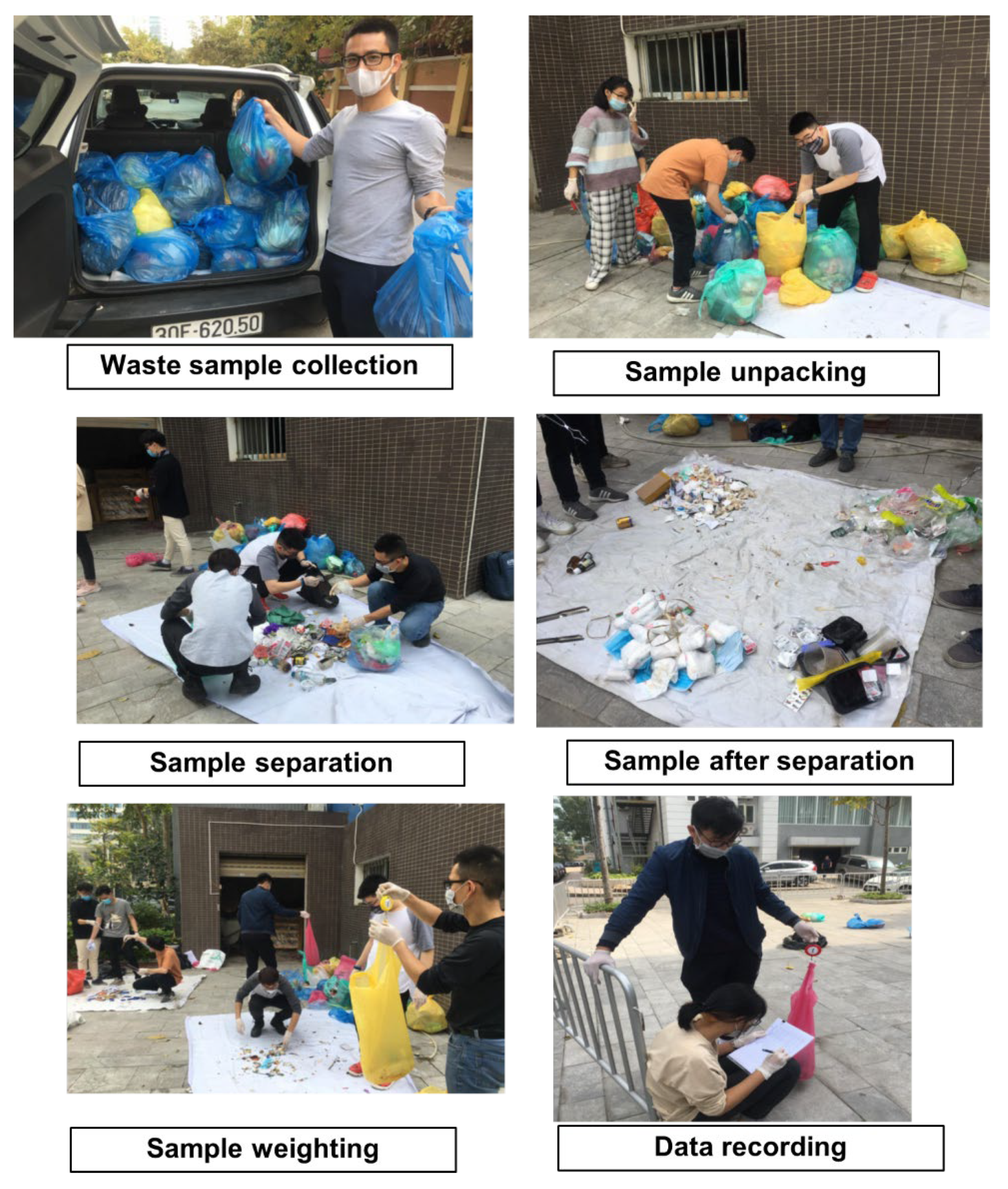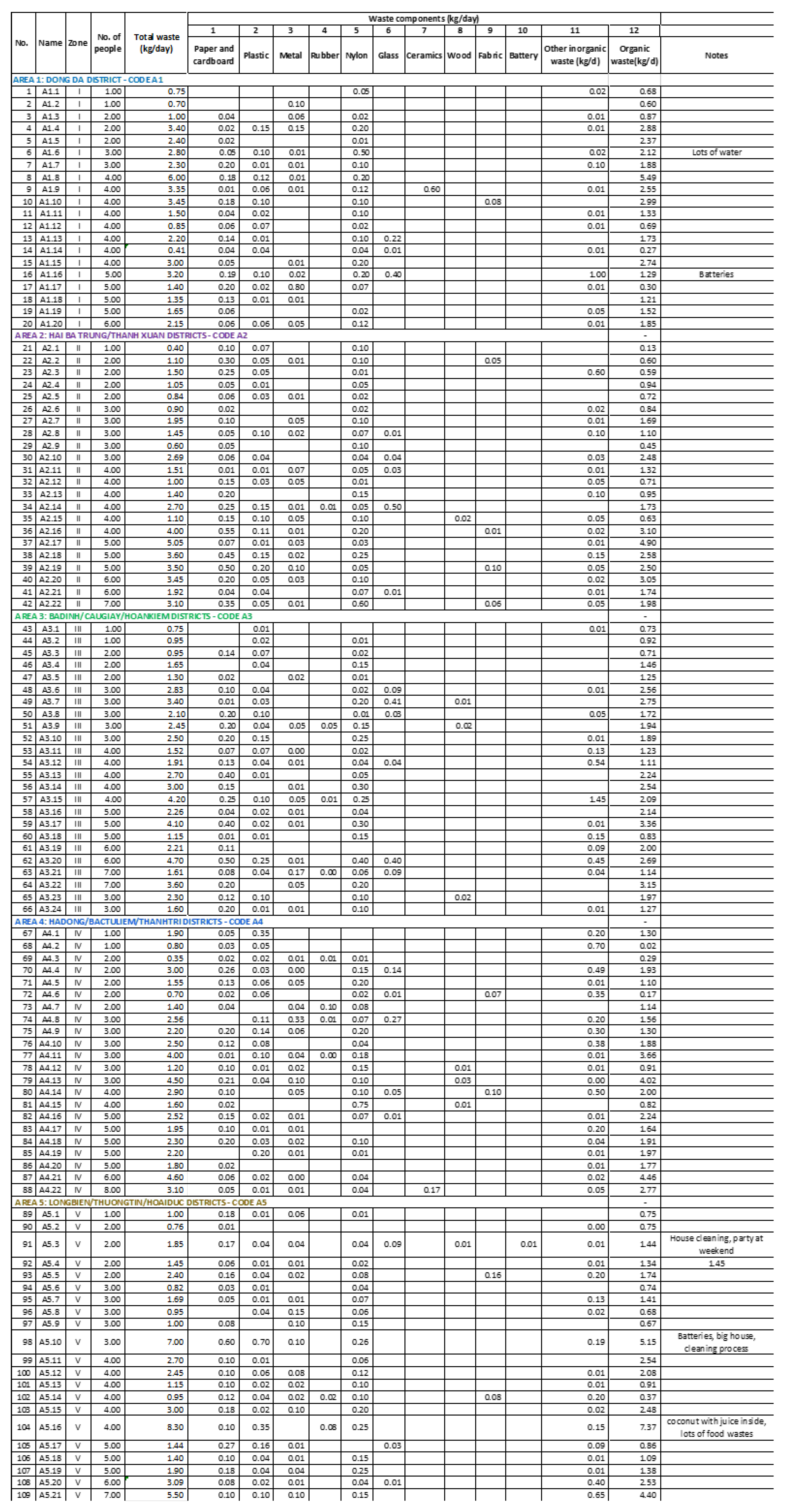1. Introduction
In order to improve municipal solid waste management (hereinafter referred to as “MSW”), it is crucial to identify the quality and quantity of municipal solid waste, of which households and commercial are major sources. This source of data is well managed in developed countries, but in developing countries, it is not clear and the reported data are assumed from small survey groups or reporting mechanisms provided by the central government. In Japan, every fiscal year, the Ministry of the Environment (MOE) publishes a report on municipal solid waste emissions and disposal with the state of (i) waste generation and disposal; (ii) waste incineration plants; (iii) landfill sites; and (iv) waste disposal expenses and compares with the data of the previous year [
1]. In the Southeast Asia region, the National Environment Agency of Singapore also has official publications on waste statistics and overall recycling annually. In 2020, under the impact of COVID-19, this country recorded a higher disposal of packing waste as online shopping and home-delivered food gained a market share. Paper and cardboard accounted for 19.4% in total generated waste [
2]. This country focuses on the recycling rate so that in the annual report, waste type, generated and recycled amounts, recycling rate, and total disposed are the five main indexes.
Waste generation and characterization are among the most important factors to consider when selecting the most appropriate collection method, treatment technology, and final disposal. Countries in the process of urbanization experience increasing population and lifestyle changes under the impact of massive immigration from rural to urban zones and higher income, which leads to considerable increase in urban waste generation. This situation causes a great burden at landfills, especially in big urban areas with very limited landfill disposal sites. Some studies have addressed this problem: Hara and Yabar (2012) discussed how the Japanese government quickly promoted proper technologies including the introduction of incineration facilities from the 1970s when Japan was dealing with the increasing amount of waste generation and then introduced more integral and proactive policies for sustainable resource management in the early 1990s [
3]. Ikhlayel et al. (2016) and Singh et al. (2014) highlighted the importance to introduce integrated waste management thinking in cities experiencing increase in amount of urban waste generation in developing countries [
4,
5].
Recently, in the state-of-the-art technologies applied in MSW, being increasing well-known is waste to energy (WtE) including thermal pyrolysis/gasification process. These methods convert MSW into syngas by a thermal process and generate steam and/or electricity, generally called energy [
6]. It is recognized as the best appropriate and economical approach for various kinds of waste such as rural waste, MSW, and industrial waste [
6]. It is widely applicable in high income countries in parallel with the recycling industry for high value recyclables from waste such as plastics, paper, and metals because the fraction of food waste and garden waste is only at 32% of total waste, and dry waste that could be recycled reaches 51% on average. These processes are intermediate treatment and reduce more than 90% waste volume to final disposal/ landfill [
7]. However, in contrast, low-and middle-income countries generate 56% and 53% food and garden waste, respectively, and in low-income countries, only 16% of the total waste stream could be recycled [
7]. This results in another direction to select treatment option. Landfill, which buries waste with or without sanitary conditions, and composting, which recycles organic matter such as leftover foods and garden leaves into a valuable fertilizer that can enrich soil and plants, are the main methods for handling waste from daily life as well as commercial and agricultural waste in low-and middle-income countries for a long time. In recent years, there has been a trend to create improvements in standards of living, following this, combustible components of waste also increase in the proportion. Incineration technology has been introduced and applied in developing countries in recent years and has become a popular selection in many municipalities. Other advanced WtE options such as pyrolysis, gasification, plasma arc gasification, and industrialized recycling scale have not been properly realized due to several social and economic constraints, although they are very environmentally friendly and profitable [
6].
In Vietnam, the amount of solid waste in 2019 has increased sharply by 46% compared to 2010 and it has become hard to find new final disposal sites in large cities due to rapid urbanization and industrialization. Ordinary solid waste occupies approximately 80% of the total solid waste. Mean collection service coverage over the nation is estimated at approximately 75%. There are 1322 waste disposal facilities nationwide including 381 incinerators, 37 composting plants, and 904 landfills, which are disposing of 13%, 16%, and 7% of the total collected amount, respectively. Most of final the disposal sites (70–80%) are inappropriately operated, that is, open dumping [
8]. Therefore, it is currently urgent to construct engineered landfills and to minimize the waste amount by means of source separation, recycling, and intermediate treatment.
To improve the solid waste management including promotion of alternative disposal methods, the data of the amount of waste and waste characteristics are extremely essential. Chapter 9 of QCVN 07/2010/BXD issued by the Ministry of Construction of Vietnam stipulates the amount of domestic waste per capita per day up to the level of urbanization [
9]. However, this QCVN does not consider the annual increase in terms of the amount of waste, and the method to determine the value. A study conducted by a JICA project reflected that the unit waste generation standard stipulated by the national technical regulation QCVN07:2010/BXD did not appropriately reflect the reality in localities. For example, according to the regulation, the unit waste generation standard for special cities and type I cities is 1.3 kg/person/day. However, under this study, data in Hue City was 0.6 kg/person/day and 0.8 kg/person/day for Da Nang City [
10]. The un-realistically high standards would lead to wasteful investment, landfill capacity estimation, and miss-arrangement and recruitment of man-power for the operation of waste treatment facilities.
In addition, although existing at approximately 30% treatment capacity by incineration and compost all over the nation, the practical effectiveness was very low. Almost all composting plants have been closed due to poor fertilizer quality that cannot meet the requirement for fertilizer by the Ministry of Agriculture and Rural Development (MARD). In addition, this technology can only be applied for medium and small sizes and sales are not good, so it is very difficult to introduce this option in a big city such as Hanoi or Ho Chi Minh City. Furthermore, incineration plants have low capacity and are back dated applied technology mainly from China or domestic manufacturers. There are still some questions regarding the emissions from these incinerators. There are some incinerators in Hanoi, Ha Nam, Phu Tho provinces that do not operate well and stop working only in a short time due to high moisture content in input mixed waste [
11]. So far, there are no waste to energy facilities in Vietnam because investment and operation costs are extremely high compared to conventional incineration, composting, and landfill. These advantages and difficulties in existing waste treatment technologies are more or less related to specific composition and characteristics of input waste. In every country, when developing a waste stream, the first step is to determine waste composition and generated volume to specify and apply suitable intermediate treatment technologies and final disposal appropriately.
To specify the necessary tasks for an integrated MSW system to overcome the above difficulties, this study was carried out by a scientific method to obtain the in-depth and reliable data of household solid waste (HSW) generation and physical composition. Additionally, it analyzed the potential in material and energy recovery based on physical composition for the second large population city in Vietnam.
4. Conclusions
This study found that household solid waste generation rate in Hanoi City was on average 2.35 kg/household/day and 0.67 kg/person/day. Household waste accounts for 70% of total waste generated across the whole city. Organics from the kitchen and garden form the largest portion in physical composition of household waste (78.9%). This rate was higher than that in other studies conducted in Hanoi City, but in the same range with other studies in different provinces and cities in Vietnam such as Ho Chi Minh City, Danang, Hue, and Can Tho. Recyclable waste accounted for about 15% and this could be recovered as either materials or energy, if we introduce a proper recycling scheme.
Other sources of municipal solid waste such as offices, restaurants, hotels, commercial areas, open markets, supermarkets, clinics, education entities, and public areas were not included in this study. While wastes from these sources have higher potential for organic waste and recyclables recovery, they are not properly sorted at the source yet. These wastes are currently collected and disposed mixed with household wastes.
The results of the study also highlight the importance of introducing alternative intermediate treatment options to deal with the high volume of organic waste such as biogas or composting, and converting waste into resources to reduce the burden for landfill and environmental impacts. It also suggests introducing a source separation at source program on a wide scale to obtain a higher quality of waste characteristics such as moisture, calorific value, etc. to easily select a suitable treatment technology.
In general, the study results provided important information on waste management systems that define the waste generation rate and physical composition from household sources. This is a basis to determine other relevant factors for the whole MSW system. Policy makers will find this useful to develop a master plan and detailed plan for the collection, transportation system, and disposal facility. One of the limitations of the study is that the sampling was conducted in one month only and this may miss some seasonal variations in waste generation. It does not cover all the influencing factors of solid waste composition and generation rate from households. Therefore, in future works, it is recommended that research is conducted on a larger scale and other generated sources by both quantitative and qualitative methods.









